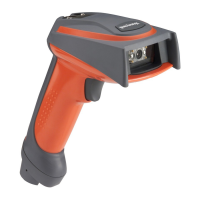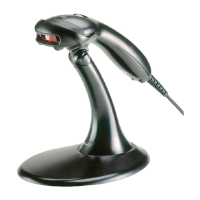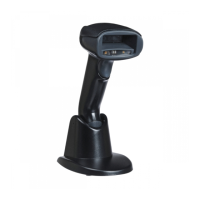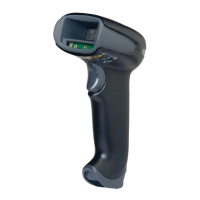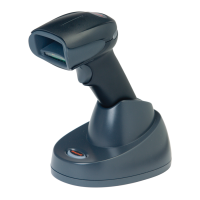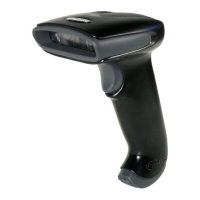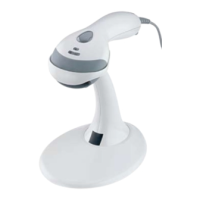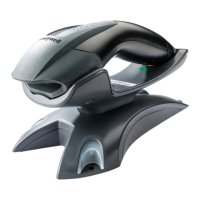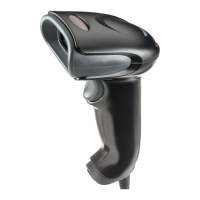Do you have a question about the Honeywell 4600g and is the answer not in the manual?
Step-by-step guide for connecting the imager via keyboard wedge.
Instructions for connecting the imager to a computer via USB.
Steps for connecting the imager via RS-232 serial port.
Guidance on connecting the imager using RS-232 wedge interface.
Scanning barcode for IBM PC AT and compatibles keyboard wedge.
Programming imager for IBM SurePos interface using Plug and Play codes.
Matching communication parameters for RS-232 data transfer.
Guidance on using the imager's aiming beam for optimal scanning.
Programming the imager with specific Terminal ID numbers.
Lists terminal types and their corresponding Terminal IDs.
Scanning country codes to program the keyboard layout.
Setting the data transmission rate for RS-232 communication.
Configuring data bits, stop bits, and parity for RS-232.
Configuring beeper and LED feedback for successful reads.
Setting the minimum time before reading another barcode.
Activating the imager via trigger or serial command.
Captures an image instead of reading a barcode.
Narrows imager's field of view to read specific barcodes.
Defines user-defined data sent before/after barcode data.
Steps to add prefixes or suffixes to barcode data.
Slows data transmission to increase data integrity.
Overview of changing imager output by inserting characters.
Details on Send, Move, Search, and Miscellaneous commands.
Interface for entering data formats and programming selections.
Options for outputting barcode data with or without formatting.
Lists primary and secondary interfaces supported by models.
Matching communication parameters for secondary RS-232.
Activating imager via trigger or serial commands for secondary interface.
Imager remains idle when Scan Stand symbol is visible.
Configures imager for automatic barcode detection.
Enables or disables decoding of all allowable symbologies.
Settings for Codabar symbology, including start/stop and check chars.
Settings for Code 39 symbology, including start/stop and check chars.
Settings for Code 93 symbology, including message length and code page.
Settings for Straight 2 of 5 IATA symbology and message length.
Settings for Code 128 symbology, concatenation, and code page.
Settings for UPC-A symbology, check digit, and number system.
Settings for Codablock F symbology and message length.
Settings for Code 16K symbology and message length.
Settings for Code 49 symbology and message length.
Settings for PDF417 symbology and message length.
Using imaging commands with modifiers for single image capture.
Applying multiple modifiers and commands within one sequence.
Capturing an image using the IMGSNP command and its modifiers.
Shipping the stored image using IMGSHP command and modifiers.
Modifiers for changing image output (Infinity Filter, Compensation, Pixel Depth).
Configures signature capture area size and location relative to barcode.
Modifiers to change size and appearance of signature image output.
Programming the imager for optical character recognition (OCR).
Enabling OCR-A, OCR-B, U.S. Currency, MICR E13B, SEMI fonts.
Note on OCR symbol misreading and single symbology reading.
Creating custom templates defining length and content of OCR strings.
Controlling data transmission with RTS/CTS, XON/XOFF, ACK/NAK.
Changing terminal ID for wand emulation.
Setting transmission rate for wand emulation.
Activating imager via trigger or serial commands.
Adjusting LED and aimer brightness.
Configures aimer and illumination LEDs for scanning.
Selectable modes for barcode decoding.
Specifies higher priority symbology for mixed labels.
Programs imager to output data in a specific order.
Sets imager orientation for direction-sensitive codes.
Enables transmission of function codes within scanned data.
Configuring wand emulation for secondary interface.
Settings for Interleaved 2 of 5 symbology, check digit, and length.
Settings for Straight 2 of 5 Industrial symbology and message length.
Settings for Matrix 2 of 5 symbology and message length.
Settings for Code 11 symbology, check digits, and message length.
Settings for Telepen symbology, output, and message length.
Settings for UPC-E0 symbology, expand, addenda, check digit.
Settings for UPC-E1 symbology.
Settings for EAN/JAN-13 symbology and check digit.
Settings for EAN/JAN-8 symbology and check digit.
Settings for MSI symbology and check character.
Settings for Plessey Code symbology and message length.
Settings for GS1 DataBar Omnidirectional symbology.
Settings for GS1 DataBar Limited symbology.
Settings for GS1 DataBar Expanded symbology and message length.
Settings for PosiCode symbology, including A/B and message length.
Settings for MicroPDF417 symbology and message length.
Settings for Postnet symbology and check digit.
Settings for Planet Code symbology and check digit.
Settings for China Post symbology and message length.
Settings for Korea Post symbology and message length.
Settings for QR Code and Micro QR Code symbology and message length.
Settings for Data Matrix symbology and message length.
Settings for MaxiCode symbology and message length.
Settings for Aztec Code symbology and message length.
Detailed specifications including dimensions, illumination, and voltage.
Detailed specifications including dimensions, illumination, and voltage.
Pinout diagrams for 10-pin modular and 9-pin Type D connectors.
Guide to isolate problems by checking power, aiming beam, and trigger.
Details Honeywell's product warranty terms and conditions.
Step-by-step guide for connecting the imager via keyboard wedge.
Instructions for connecting the imager to a computer via USB.
Steps for connecting the imager via RS-232 serial port.
Guidance on connecting the imager using RS-232 wedge interface.
Scanning barcode for IBM PC AT and compatibles keyboard wedge.
Programming imager for IBM SurePos interface using Plug and Play codes.
Matching communication parameters for RS-232 data transfer.
Guidance on using the imager's aiming beam for optimal scanning.
Programming the imager with specific Terminal ID numbers.
Lists terminal types and their corresponding Terminal IDs.
Scanning country codes to program the keyboard layout.
Setting the data transmission rate for RS-232 communication.
Configuring data bits, stop bits, and parity for RS-232.
Configuring beeper and LED feedback for successful reads.
Setting the minimum time before reading another barcode.
Activating the imager via trigger or serial command.
Captures an image instead of reading a barcode.
Narrows imager's field of view to read specific barcodes.
Defines user-defined data sent before/after barcode data.
Steps to add prefixes or suffixes to barcode data.
Slows data transmission to increase data integrity.
Overview of changing imager output by inserting characters.
Details on Send, Move, Search, and Miscellaneous commands.
Interface for entering data formats and programming selections.
Options for outputting barcode data with or without formatting.
Lists primary and secondary interfaces supported by models.
Matching communication parameters for secondary RS-232.
Activating imager via trigger or serial commands for secondary interface.
Imager remains idle when Scan Stand symbol is visible.
Configures imager for automatic barcode detection.
Enables or disables decoding of all allowable symbologies.
Settings for Codabar symbology, including start/stop and check chars.
Settings for Code 39 symbology, including start/stop and check chars.
Settings for Code 93 symbology, including message length and code page.
Settings for Straight 2 of 5 IATA symbology and message length.
Settings for Code 128 symbology, concatenation, and code page.
Settings for UPC-A symbology, check digit, and number system.
Settings for Codablock F symbology and message length.
Settings for Code 16K symbology and message length.
Settings for Code 49 symbology and message length.
Settings for PDF417 symbology and message length.
Using imaging commands with modifiers for single image capture.
Applying multiple modifiers and commands within one sequence.
Capturing an image using the IMGSNP command and its modifiers.
Shipping the stored image using IMGSHP command and modifiers.
Modifiers for changing image output (Infinity Filter, Compensation, Pixel Depth).
Configures signature capture area size and location relative to barcode.
Modifiers to change size and appearance of signature image output.
Programming the imager for optical character recognition (OCR).
Enabling OCR-A, OCR-B, U.S. Currency, MICR E13B, SEMI fonts.
Note on OCR symbol misreading and single symbology reading.
Creating custom templates defining length and content of OCR strings.
Controlling data transmission with RTS/CTS, XON/XOFF, ACK/NAK.
Changing terminal ID for wand emulation.
Setting transmission rate for wand emulation.
Activating imager via trigger or serial commands.
Adjusting LED and aimer brightness.
Configures aimer and illumination LEDs for scanning.
Selectable modes for barcode decoding.
Specifies higher priority symbology for mixed labels.
Programs imager to output data in a specific order.
Sets imager orientation for direction-sensitive codes.
Enables transmission of function codes within scanned data.
Configuring wand emulation for secondary interface.
Settings for Interleaved 2 of 5 symbology, check digit, and length.
Settings for Straight 2 of 5 Industrial symbology and message length.
Settings for Matrix 2 of 5 symbology and message length.
Settings for Code 11 symbology, check digits, and message length.
Settings for Telepen symbology, output, and message length.
Settings for UPC-E0 symbology, expand, addenda, check digit.
Settings for UPC-E1 symbology.
Settings for EAN/JAN-13 symbology and check digit.
Settings for EAN/JAN-8 symbology and check digit.
Settings for MSI symbology and check character.
Settings for Plessey Code symbology and message length.
Settings for GS1 DataBar Omnidirectional symbology.
Settings for GS1 DataBar Limited symbology.
Settings for GS1 DataBar Expanded symbology and message length.
Settings for PosiCode symbology, including A/B and message length.
Settings for MicroPDF417 symbology and message length.
Settings for Postnet symbology and check digit.
Settings for Planet Code symbology and check digit.
Settings for China Post symbology and message length.
Settings for Korea Post symbology and message length.
Settings for QR Code and Micro QR Code symbology and message length.
Settings for Data Matrix symbology and message length.
Settings for MaxiCode symbology and message length.
Settings for Aztec Code symbology and message length.
Detailed specifications including dimensions, illumination, and voltage.
Detailed specifications including dimensions, illumination, and voltage.
Pinout diagrams for 10-pin modular and 9-pin Type D connectors.
Guide to isolate problems by checking power, aiming beam, and trigger.
Details Honeywell's product warranty terms and conditions.
| Wavelength | 617 nm |
|---|---|
| Tilt angle range | 27 - 42 ° |
| Decoding standards | 1D, 2D |
| Optical sensor resolution | 752 pixels |
| Dimensions (WxDxH) | 81 x 135 x 157 mm |
| Standard interfaces | USB, RS-232, Keyboard wedge, RS-485 |
| Input voltage | 4 - 14 V |
| Power consumption | 382 mA |
| Certification | FCC Part 15, ICES-003, EN55022 Class A, ROHS, CE, UL |
| Product color | Gray |
| Storage temperature (T-T) | -40 - 70 °C |
| Operating temperature (T-T) | 0 - 50 °C |
| Operating relative humidity (H-H) | 0 - 95 % |
| Weight | 184 g |
|---|


